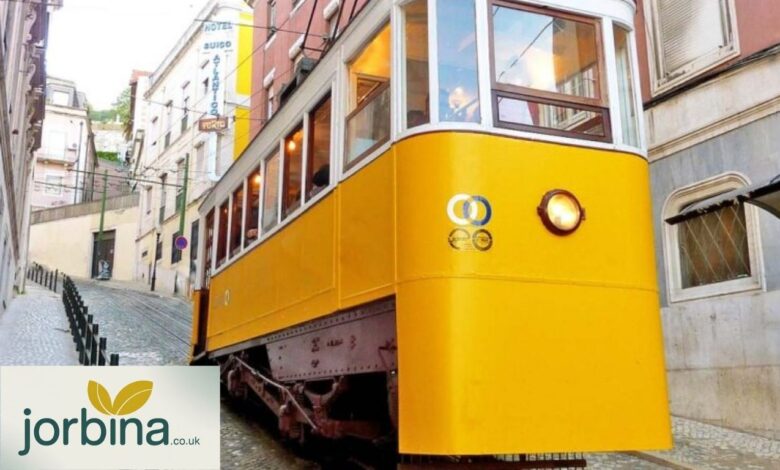Lisbon Funicular Advice Nobody Notifies You Before You Leave

Have you ever attempted a midday walk up Lisbon’s hills? You feel as though you never signed up for this workout. Funiculars are in the city for this reason. You can travel through history and save your legs by riding these quaint little trams up even the steepest streets. They are living landmarks in addition to being useful modes of transportation. Here are some pointers to help you have a more pleasurable and less confusing ride before you board.
The Unique Features of Lisbon’s Funiculars
Lisbon is referred to as the “city of seven hills.” Until you see how steep those hills are, that sounds poetic. Funiculars were constructed by engineers in the late 1800s to allow people to travel between neighborhoods without wearing themselves out. Because they are an integral part of Lisbon’s identity, they have endured into the modern era, not because the city lacks transportation options. Even though you’re still a part of the city’s everyday routine, riding them now feels like traveling back in time.
Meet the Three Lisbon Funiculars
Lisbon has three funiculars, and each one feels different.
- Elevador da Glória: This one connects Restauradores Square to Bairro Alto. It’s the most famous and the most colorful thanks to the graffiti that covers its cars. It’s also the busiest since it drops you near nightlife central.
- Elevador da Bica: If you’ve seen pictures of a yellow tram rolling down a narrow street with the Tagus River in the background, that’s Bica. It’s the most photogenic of the three and a favorite among photographers.
- Elevador do Lavra: This is Lisbon’s oldest funicular, first opened in 1884. It’s tucked away near Avenida da Liberdade and often overlooked by tourists, which makes it feel more authentic and peaceful.
If you only have time for one ride, most travelers choose Bica for the iconic view.
Purchasing Tickets Without Any Trouble
Many tourists are unaware that you do not have to purchase a ticket each time you ride. The Viva Viagem card, which can be loaded with a 24-hour public transportation pass, is the most intelligent choice. It includes all three funiculars, buses, trams, and the metro. You’ll avoid waiting in line and save money.
Be sure to have cash on hand if you would rather purchase a single ticket. You’ll avoid some awkward situations because conductors frequently don’t have change for larger notes.
Selecting the Appropriate Time to Ride
It’s all about timing. You’ll be crammed with tourists taking pictures everywhere you go if you ride during the day. You will ride the tram with locals going to work if you arrive early in the morning. When you ride in the evening, the city will be illuminated by streetlights as the temperature drops. Late afternoon is literally the golden hour if you want to take pictures. Soft light shines on the cobbled streets, tracks, and tiled houses.
Walking Beside the Tracks
You don’t always have to ride to enjoy the funiculars. The streets that run alongside them are just as fascinating. Walking beside the tracks lets you appreciate the steepness of the climb, admire the buildings up close, and even capture photos of the tram from different angles. Many locals actually skip the ride and just walk—it’s free, and it’s good exercise. Still, don’t skip the tram entirely. The feeling of being pulled uphill in a century-old carriage is part of the charm.
Inside the Tram: What to Expect
Step inside, and you’ll find wooden benches, brass handles, and windows that let in Lisbon’s breeze. The ride is short—usually under five minutes—but it feels timeless. You’ll likely notice a mix of locals sitting quietly while tourists take photos from every angle. That mix is exactly what makes the atmosphere so unique.
Where to Take the Best Photos
The Lisbon funiculars are basically photo magnets, but here’s where to capture the perfect shot:
- Glória: Stand midway up the hill and frame the tram with the city behind it.
- Bica: Go to the top and shoot downward. You’ll see the tram heading toward the river—a postcard-perfect view.
- Lavra: Capture the tram at the bottom station where it peeks out between leafy trees and cobblestones.
Be respectful, though. These are residential streets, and people live in the houses you’re photographing.
Escaping the Crowds
Glória and Bica attract the biggest crowds, especially on weekends. If you’d rather avoid the chaos, ride Lavra. Most tourists never find it, and you’ll often have the carriage nearly to yourself. Another trick is to go during weekdays or early mornings. Lisbon wakes up late, so you’ll find fewer people before 9 a.m.
A Short Lesson in History
The funiculars originally ran using a water counterbalance system. The car at the top would fill with water to make it heavier, which pulled the lower car up the hill. Later, electricity took over, but the principle of balance still applies. Knowing this adds a little magic to the ride—it’s not just a tram, it’s a working piece of engineering history.
Is It Worth the Ticket Price?
The ride is short, so it’s fair to ask if it’s worth it. The answer is yes. You’re not paying for distance; you’re paying for experience. It’s about being part of something that has carried generations of Lisboetas up these hills. If you’re on a tight budget, just ride one funicular—Bica for views, Glória for energy, or Lavra for peace. You’ll still come away with a memory that feels very “Lisbon.”
What to Do After the Ride
Each funicular delivers you to a neighborhood worth exploring:
- Glória leaves you at Bairro Alto, known for its lively bars, restaurants, and fado music.
- Bica also connects to Bairro Alto but from a different angle, giving you access to cozy streets, rooftop cafés, and tiny restaurants.
- Lavra puts you near Avenida da Liberdade, one of the city’s most elegant boulevards, lined with trees and shops.
Think of the tram not as the main event but as the doorway into a new part of the city.
Riding at Night
Night rides feel completely different. The streets glow under the lamps, the air cools, and in Bairro Alto, the nightlife begins to buzz. Glória is especially atmospheric after dark because it connects directly to the party district. If you’ve already ridden during the day, try it again at night—you’ll feel like you’re in a different city.
Staying Safe
Lisbon is generally safe, but the funiculars do attract pickpockets due to the crowds. Keep your bag zipped and your phone close. Don’t stress too much—it’s unlikely you’ll have a problem—but staying aware means you can relax and enjoy the ride.
Fun Facts to Impress Friends
- Bica is the only funicular that runs directly toward the river.
- Locals call them “elevadores,” even though technically they’re funicular railways.
- The graffiti on Glória changes constantly, which means no two rides ever look the same.
These details might seem small, but they give you a story to share when you’re back home.
Locals Still Use Them Every Day
While tourists take photos, locals actually depend on these trams. Older residents use them to avoid the exhausting climbs, students treat them as shortcuts, and sometimes delivery workers even hop on board. They’re not museum pieces—they’re part of Lisbon’s daily rhythm.
Family and Group Tips
Traveling with kids? They’ll love it—the funiculars feel like something out of a storybook. If you’re in a group, be ready to split up. The cars are small, and fitting everyone in one ride isn’t always possible. Meeting at the top or bottom is easy, and the ride only takes a few minutes.
My Personal Recommendation
After trying all three, my vote goes to Bica. That downhill view toward the Tagus River is unbeatable. Glória is lively and fun, especially if you’re heading to Bairro Alto at night, and Lavra feels peaceful and underrated. But if you can only choose one, Bica captures the spirit of Lisbon best.
Bottom Line
The Lisbon funiculars aren’t just transport—they’re experiences. They’re short, sweet, and full of character. Ride one, take your photos, and enjoy the creak of the old wooden seats. Imagine how many people have made the same journey over the past century. It’s a small adventure, but one that stays with you.
High-Traffic Website Links (Directly Related)
- Official Carris Funiculars Page → Carris Funicular Information (tickets, timetables, and routes for Glória, Bica, and Lavra).
- Visit Lisboa Funicular Guide → Visit Lisboa: Elevators & Funiculars (official tourism site with history and visitor details).
YouTube Video (Authentic Ride Experience)
- Bica Funicular POV Ride → Lisbon Bica Funicular Ride – YouTube (full ride experience down toward the Tagus River).
Social Media Links (Engagement + Visuals)
- Instagram Hashtag Feed → #LisbonFunicular on Instagram (user-generated photos of all 3 funiculars).
- Pinterest Board → Lisbon Funicular Photos (visual inspiration for travelers and photographers).
FAQs
What is the best funicular to take in Lisbon?
Because of its picture-perfect view of the Tagus River below, most tourists claim that the Bica is the best. It has the strongest “Lisbon feel” and is also the most photographed.
Which funicular in Lisbon crashed?
Due to a technical malfunction, the Glória funicular slid backward and struck the other vehicle in 2004. Fortunately, no serious injuries occurred, and since then, the system has been updated.
Is the Glória funicular worth it?
Yes, particularly if you intend to spend the evening in Bairro Alto. It puts you squarely in the center of the action and is vibrant and busy.
What is the funicular railway in Lisbon?
Funiculars are short railroads that resemble trams and transport people up steep hills in Lisbon. Glória, Bica, and Lavra are the three.
Why is Tram 28 so popular in Lisbon?
The funiculars are not the same as Tram 28. From Alfama to Baixa, Lisbon’s most famous neighborhoods are traversed by this historic yellow tram. It’s well-liked because it resembles a moving city sightseeing tour.



